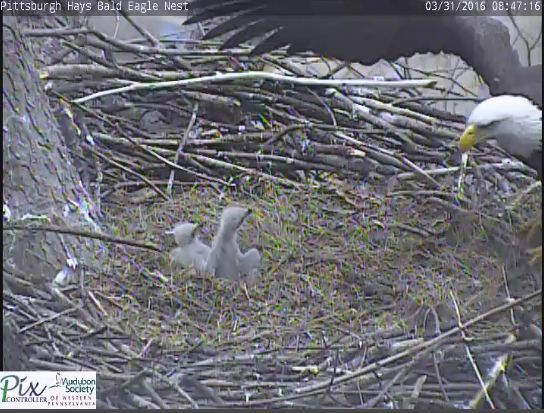
By now it’s clear that the two nestlings in the Hays bald eagle nest are doing well but many of you wonder about the third unhatched egg. What will happen to it? Why hasn’t it hatched?
One unhatched egg is a fairly common occurrence in the nests of many birds. Some eggs are not fertile, some have developmental issues. There are many reasons. Birds often lay more eggs than actually hatch, perhaps as insurance against this rather common eventuality.
Among bald eagles, the need to brood the young for a week allows ample opportunity for remaining eggs to continue incubation and eventually hatch. While the adults brood the nestlings they can hear if an egg has a live bird in it because baby birds make peeping and hammering sounds inside the egg a day or more before hatching. Eggs that aren’t going to hatch are silent.
What happens to unhatched eggs? Birds are not emotional about them. When it’s obvious an egg won’t hatch, the family moves it around the nest for their convenience. In bald eagles’ nests it may eventually become buried under debris along with the remains of dinner.
What if it hatches now, more than a week late? Here’s the answer from the Audubon Society of Western PA on their Bald Eagles of Western PA Facebook page on March 30, 9:39pm:
“We’ve gotten many questions about the last egg in the Hays nest. At this point there are no good options for what can happen with that egg. Perhaps the egg is just not viable and will not hatch. But if the egg should hatch (there is still a remote possibility) the newly-hatched eaglet would have a difficult time thriving. It would be more than a week younger than its siblings, meaning it would be much smaller and have a hard time competing for available food. While nobody likes to hear this, it is nature and if we didn’t have a webcam focused on the nest, we wouldn’t even know it was happening. All we can do now is wait and see how it plays out…and be thankful for the two vibrant eaglets that we do have in Hays.” — eagles.aswp.org
The text above gives you a hint.
Knowing bald eagle family life as I do, my hope is that the third egg never hatches.
UPDATE, 2 April 2016, 7:36am: See below for a press release about Egg#3 from the Audubon Society of Western PA.

Audubon Society of Western Pennsylvania Statement on the Remaining Egg in the Hays, PA Bald Eagle Nest
For immediate release, April 2, 2016.
There is one unhatched egg remaining in the Hays, PA Bald Eagle nest. The egg has gone one week past the typical 35 day incubation period and at this time, the adult eagles are no longer actively incubating the egg. Audubon believes that the egg is not viable and will not hatch.
While we will never know for certain why this egg did not hatch, it’s possible that it was not fertile from the start. An infertile egg cannot develop into an eaglet and the egg would thus be deemed non-viable. It’s also possible that something went wrong developmentally within the egg after it was laid.
Across the state in Hanover, it appears that their local Bald Eagles also have an egg that is not going to hatch. We do not believe that there is any connection between the non-hatchings in Hanover and Hays—it’s nothing more than a coincidence. Last year, both sides of Pennsylvania had abnormally cold winters, which we believe was one of the factors that led to an unsuccessful breeding season for our Pittsburgh Bald Eagles. But in 2015, the Hanover Bald Eagles raised and fledged young, while facing the same cold temperatures. Before webcams were pointed on these nests, we did not know what was happening inside of them. Today we can see nature at work—both the good and the hard, sometimes uncomfortable reality of it.
The positive news is that the Hays Bald Eagles have two healthy and vibrant eaglets in their nest—eaglets that are approaching two weeks old and growing every day. We look forward to watching their continued growth and development, and eventual fledging from the nest in early summer. The Hays Bald Eagles have successfully hatched six eaglets: one in 2013, three in 2015, and two in 2016. The unhatched egg will eventually be broken through activity in the nest—parents and eaglets moving around. The egg, like the shells of the hatched eaglets, will eventually become invisible within the nest. An image of the female Hays Bald Eagle and two eaglets is attached.
Watch Pittsburgh’s eagles at eagles.aswp.org. For additional information on the Hays and Harmar Bald Eagles, please visit our Facebook page, www.facebook.com/pittsburgheagles, where daily updates on both nests are posted. The Harmar Bald Eagles’ first egg is expected to hatch on our around April 13.
(photo from Hays eaglecam)
p.s. Celebrate bald eagles this weekend at Audubon Society of Western PA’s Beechwood (Allegheny County) and Succop (Butler County) locations with a free “Eagle Egg” Hunt and other activities.
On Saturday, April 2 at Beechwood: Egg hunts at 11 am, 12 pm, and 1 pm – bring a bag to collect eggs! Parking is at Fairview Elementary School, 738 Dorseyville Road. Shuttles will bring visitors to Beechwood Farms Nature Reserve. Please allow time for the shuttle to transport you to the event. The Pennsylvania Game Commission and PixController will be onsite, as well as a local chicken expert who will bring baby chickens! There will also be games, crafts, and activities. Register today for Beechwood!
On Sunday, April 3 at Succop: Egg hunt begins at 12 pm – bring a bag to collect eggs! Then participate in eagle-themed games, crafts, and activities. Register today for Succop!
Or call (412) 963-6100 to sign up.
Thank you Kate! <3